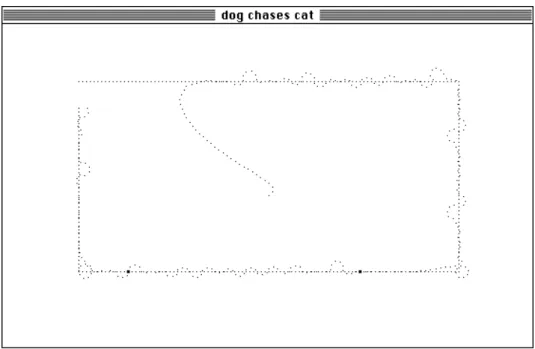Educational Material
Introduction to fuzzy control
Author(s):
Geering, Hans P.
Publication Date:
1998
Permanent Link:
https://doi.org/10.3929/ethz-a-004953512
Rights / License:
In Copyright - Non-Commercial Use Permitted
This page was generated automatically upon download from the ETH Zurich Research Collection. For more information please consult the Terms of use.
ETH Library
Introduction to Fuzzy Control
Hans P. Geering
Abstract
In this report, some of the basic mathematical definitions and rules of fuzzy system theory are described inasmuch as they are relevant for fuzzy control. Two examples are covered in detail, viz., a fuzzy closed- loop halting control scheme for the forward motion of a mobile robot in an automatic factory and a dog chasing a cat using fuzzy control.
Issues of computational efficiency are discussed. And some recommen- dations to potential designers of fuzzy controllers are summarized.
After studying this report, the reader should be in a position to design simple fuzzy controllers and simulate the behaviour of the resulting fuzzy control system on a general purpose digital computer.
IMRT Press
° c Measurement and Control Laboratory Swiss Federal Institute of Technology (ETH)
ETH-Zentrum
CH-8092 Zurich, Switzerland 3 rd ed., September, 1998
i
CONTENTS iii
Contents
1 Fuzzy Sets . . . . 1
2 Fuzzification . . . . 2
3 Fuzzy Logic . . . . 2
4 Fuzzy Variables . . . . 3
4.1 Introducing Fuzzy Variables . . . . 3
4.2 Fuzzification Revised . . . . 4
4.3 Fuzzy Vectors . . . . 4
5 Fuzzy Rules . . . . 5
5.1 Fuzzy SISO-Rule . . . . 5
5.2 Fuzzy AND-Rules . . . . 5
5.3 Other Fuzzy Rules . . . . 6
6 Fuzzy Associative Memory . . . . 6
7 Defuzzification . . . . 7
8 Fuzzy Control Systems . . . . 8
8.1 Structure of a Fuzzy Control System . . . . 8
8.2 Example 1: Closed-loop halting control . . . . 10
8.3 Example 2: Dog chasing cat . . . . 15
9 Computational Issues . . . . 18
9.1 Efficient Defuzzification . . . . 18
9.2 Derivatives of the Control Function . . . . 20
9.3 Observations and Suggestions . . . . 21
References . . . . 22
1 FUZZY SETS 1
1 Fuzzy Sets
Definition: A fuzzy set s is an ordered pair (X, f ), where X is a vector space (usually the real line R) and f is a set membership function mapping X onto the interval [0, 1] of the real line R, i.e., f : X → [0, 1].
In a fuzzy control problem, X is the signal space of a signal or a vector signal, respectively.
A set S ⊂ X is associated with the fuzzy set s = (X, f ) in a natural way:
S = cl { x ∈ X | f (x) > 0 } is the closure of the set in X where f attains positive values.
Notice that the set membership function f is normalized in the sense that the value f (x) = 1 is attained for at least one element x ∈ S ⊂ X. However, this normalization has mainly been introduced for practical and intuitive reasons.
Mathematically speaking, this normalization is dispensable.
Usually, a fuzzy set is a constant construct, i.e., a time-invariant part of a fuzzy control system.
- 6
1
0
-20 -10 0 10 20
f i
A X A A
A A Z
T T T
T T
P S P L
T T T
T T N S
@ @
@ @
@ N L
Figure 1: Fuzzy sets N L (negative large), N S (negative small), Z (zero), P S (positive small), and P L (positive large) covering the real line X = R.
The following two scalar characteristics of a fuzzy set will be useful later.
Definition: The weight w and the centroid c of a fuzzy set s = (X, f ) are defined as follows:
w = Z
f (x) dx and
c =
R xf (x) dx R f (x) dx
where all of the integrals are taken over the signal space X.
2 Fuzzification
Consider a signal space X covered by several fuzzy sets s i , i = 1, . . . , k. The fuzzy question is: Given a vector x ∈ X, to which of the fuzzy sets s i does x belong or, in which of the sets S i associated with the fuzzy sets s i does x lie?
In mathematical set theory, the answer for each of the sets S i is a binary one. In fuzzy set theory, set membership is “by degree”.
Definition: Consider a fuzzy set s = (X, f ). An arbitrary element x ∈ X belongs to the fuzzy set s with degree d = f (x).
Hence, the answer to the fuzzy question is: x belongs to each of the fuzzy sets s i to some degree, viz., to degrees d i = f i (x), i = 1, . . . , k.
Examples: Consider the fuzzy sets N L, N S, Z , P S , and P L defined on the signal space X = R which are displayed in Figure 1.
a) The element x = − 20 is “negative large” to degree 1 and “negative small”,
“zero”, “positive small”, and “positive large” to degrees 0.
b) The element x = 2 is “negative large” and “negative small” to degrees 0,
“zero” to degree 0.52, “positive small” to degree 0.4, and “positive large” to degree 0.
3 Fuzzy Logic
Fuzzy logic defines the rules governing the operators intersection and union of fuzzy sets.
Consider two fuzzy sets s 1 = (X, f 1 ) and s 2 = (X, f 2 ) defined on the same signal space X and their associated sets S 1 ⊂ X and S 2 ⊂ X, respectively.
Definition: An arbitrary element x ∈ X belongs to the union s 1 ∪ s 2 of the two fuzzy sets s 1 and s 2 with degree d = max(f 1 (x), f 2 (x)).
Definition: An arbitrary element x ∈ X belongs to the intersection s 1 ∩ s 2 of the two fuzzy sets s 1 and s 2 with degree d = min(f 1 (x), f 2 (x)).
Consequently, the union operator and the intersection operator yield the fuzzy sets s 1 ∪ s 2 = (X, max(f 1 , f 2 )) and s 1 ∩ s 2 = (X, min(f 1 , f 2 )), respectively.
Notice that the intersection s 1 ∩ s 2 is a degenerated fuzzy set in the sense that
its set membership function min(f 1 , f 2 ) does not map onto the interval [0, 1] as
requested by the definition of a fuzzy set. This detail is not pursued any further
here because in fuzzy control, all calculations are done with fuzzy variables
rather than with fuzzy sets.
4 FUZZY VARIABLES 3
4 Fuzzy Variables
4.1 Introducing Fuzzy Variables
Definition: A fuzzy variable v is an ordered pair (s, d) where s is a fuzzy set and d ∈ [0, 1] a real bounded variable.
Fuzzy variables arise in the fuzzification operation in a natural way: For the variable x ∈ X , the real variable d is the degree of membership in the fuzzy set s. (Cf. Section 4.2)
In another interpretation of a fuzzy variable, the real variable d “modulates”
the fuzzy set s: The scalar d and the set membership function f : X → [0, 1] of the fuzzy set s define a new function g : X → [0, 1]. There are two modulation schemes:
a) “linear modulation”: g(x) = d · f (x) b) “modulation by clipping”: g(x) = min(f (x), d).
- -
6 6
1 1
0 0
g, f g, f
X X
f f
g g
a) b)
pp pp pp pp ppp p p p p p p p p p p p p p p p p pppp p pppp
p pppp p p pp pp pp pp ppp p p p p p p p p p p p p p p p p pppp
p pppp p pppp p p XXX
HH HH @
@@
Figure 2: Example of a fuzzy variable: fuzzy set (X, f ) modulated by d = 0.5:
a) linear modulation, b) modulation by clipping.
The author prefers the linear modulation scheme because the function g ob- tained by linear modulation typically contains more detailed information about the structure of the fuzzy variable.
In Section 1, the weight w and the centroid c of a fuzzy set s = (X, f ) have been defined. Obviously, the weight and the centroid of a fuzzy variable v can be defined in an analogous way by replacing the set membership function f by the modulated function g in these formulae.
Notice that the linear modulation scheme results in a linear reduction of the weight of the fuzzy variable, w v = d · w s , while the centroid remains unchanged, c v ≡ c s for all d ∈ (0, 1].
For calculations with a fuzzy variable, it is more practical to use the “mod-
ulated” function g than to keep the scalar d and the set membership function
f of the underlying fuzzy set s apart. Furthermore, the restriction g(x) ≤ 1 for
all x ∈ X can be dropped. This is practical when sums of fuzzy variables are
calculated.
4.2 Fuzzification Revised
Consider a signal space X covered by the N fuzzy sets s 1 , . . . , s N . An arbitrary element x ∈ X belongs to the fuzzy sets s 1 , s 2 , . . . , and s N to degrees d 1 = f 1 (x), d 2 = f 2 (x), . . . , and d N = f N (x), respectively.
Using fuzzy variables leads to the following definition of the fuzzification operation.
Definition: The fuzzification operator F maps an element x ∈ X to the set of fuzzy variables { (s 1 , f 1 (x)), (s 2 , f 2 (x)), . . . (s N , f N (x)) } .
Examples: Reconsider the examples a) and b) of Section 2. With the above definition we can rewrite the results succinctly in the following way:
a) F : − 20 7→ { (N L, 1), (N S, 0), (Z, 0), (P S, 0), (P L, 0) } and b) F : 2 7→ { (N L, 0), (N S, 0), (Z, 0.52), (P S, 0.4), (P L, 0) } .
4.3 Fuzzy Vectors
As the example in Section 4.2 shows, introducing vector notation in the range space of the fuzzification operator F is efficient.
Again, consider a signal space X covered by the N fuzzy sets s 1 , . . . , s N . The fuzzification F (x) of an arbitrary element x ∈ X can be represented by an N -vector in several equivalent ways:
F (x) =
v 1 v 2 .. . v N
(x) =
(s 1 , f 1 (x)) (s 2 , f 2 (x))
.. . (s N , f N (x))
∼ =
f 1 (x) f 2 (x)
.. . f N (x)
.
The relation operator “ ∼ =” points out the fact that, in the last vector, the fuzzy sets s i are not explicitly noted down but are implied by the indices i.
On the other side, every fuzzy n-vector can be represented by the corre- sponding modulated set membership functions g i :
v 1 v 2 .. . v n
=
(s 1 , d 1 ) (s 2 , d 2 )
.. . (s n , d n )
=
g 1 g 2
.. . g n
∼ =
(w g
1, c g
1) (w g
2, c g
2)
.. . (w g
n, c g
n)
.
Here, the relation operator “∼ =” points out the fact that the weight w g
iand the centroid c g
ido not completely characterize the fuzzy variable v i .
This representation is useful at the outputs of the fuzzy rules describing a
fuzzy controller.
5 FUZZY RULES 5
5 Fuzzy Rules
Fuzzy rules are used in fuzzy control in order to define the map from the fuzzified input signals (error signals, measured signals, or command signals) of the fuzzy controller to its fuzzy output signals (control signals).
5.1 Fuzzy SISO-Rule
Consider a fuzzy set s e = (E, f e ) defined on the signal space E where the error signal e “lives” and a fuzzy set s u = (U, f u ) defined on the signal space U where the control signal u “lives”. (Usually, E = R and U = R, hence the designation
“SISO-rule”.)
Definition: The SISO-rule mapping the fuzzy input variable v e = (s e , d e ) to the fuzzy output variable v u = (s u , d u ) (of the fuzzy controller) is defined by v u = (s u , d e ).
In the jargon of control engineering, this definition should be read as follows:
If the value e(t) of the error signal belongs to the fuzzy set s e to degree d e then the fuzzy set s u of the control signal is fired to degree d u = d e , i.e., modulated by d u = d e .
In shorthand notation, the fuzzy SISO-rule is denoted by s e ⇒ s u , where the degree of firing d u = d e is implied.
The value u(t) of the control signal is obtained later by “defuzzification”
after all of the fuzzy rules pertaining to the control signal have been processed.
5.2 Fuzzy AND-Rules
Consider two fuzzy sets s e1 = (E 1 , f e1 ) and s e2 = (E 2 , f e2 ) defined on the signal spaces E 1 and E 2 , respectively, where the error signals e 1 and e 2 “live” and a fuzzy set s u = (U, f u ) defined on the signal space U where the control signal u
“lives”.
Definition: The AND-rule mapping the fuzzy input variables v e1 = (s e1 , d e1 ) and v e2 = (s e2 , d e2 ) to the fuzzy output variable v u = (s u , d u ) is defined by v u = (s u , min(d e1 , d e2 )).
In the jargon of control engineering, this definition should be read as follows:
If the value e 1 (t) of the first error signal belongs to the fuzzy set s e1 to degree d e
1and the value e 2 (t) of the second error signal belongs to the fuzzy set s e2 to degree d e2 then the fuzzy set s u of the control signal is fired to the smaller of the two degrees, i.e., d u = min(d e1 , d e2 ).
In shorthand notation, the fuzzy AND-rule is denoted by s e
1∩ s e
2⇒ s u ,
where the degree of firing d u = min(d e
1, d e
2) is implied.
The value u(t) of the control signal is obtained later by “defuzzification”
after all of the fuzzy rules pertaining to the control signal have been processed.
It should be obvious how the definition of the fuzzy AND-rule can be ex- tended to three or more fuzzy input variables.
5.3 Other Fuzzy Rules
In analogy to the fuzzy AND-rules, fuzzy OR-rules or more complicated logical combinations for fuzzy rules could be defined.
The author prefers to use fuzzy AND-rules exclusively because OR-ing sev- eral AND-rules together typically results in a weaker contribution to the overall fuzzy output variable(s) and the corresponding defuzzified control variable(s).
Therefore, in the remainder of this report “fuzzy rule” stands for “fuzzy AND-rule” or its SISO special case “fuzzy SISO-rule”.
6 Fuzzy Associative Memory
For a fuzzy controller, the collection of all of its fuzzy rules is called the fuzzy associative memory.
For every control cycle, each of the fuzzy rules is evaluated. This can be done by massively parallel processing. The output of each fuzzy rule is a fuzzy variable.
The output of the fuzzy associative memory is equal to the (vector) sum of all these fuzzy variables:
In the case of a scalar control signal u(t), the signal space is the real line, U = R. Summing the fuzzy variables involves calculating the sum g u = P
j g j of their modulated functions g j . — Notice that the fuzzy variable v u at the output of the fuzzy associative memory is represented exclusively by the (“modulated”) function g u . (I.e., this fuzzy variable has no directly underlying fuzzy set which is modulated by some degree d u to yield the function g u .)
In the case of a vector control signal u(t) ∈ R m , typically, the signal space of each of the components u i (t) is the real line, i.e., U i = R for i = 1, . . . , m.
Summing the fuzzy variables involves calculating the m sums g u
i= P
j g ij of the modulated functions g ij for each index i, i = 1, . . . , m.
Of course, the summing operator P
takes the pointwise sum of its argument
functions. As mentioned in Section 4.1, the sum g(u) may execeed 1 for some
values of the argument u. This poses no problem (cf. Section 7). (Clipping g(u)
to the maximal value 1 would be counterproductive because the centroid of g
would be shifted.)
7 DEFUZZIFICATION 7
7 Defuzzification
Defuzzification is the process of assigning a representative value to a fuzzy vari- able. Consider a fuzzy variable v u on the signal space U = R which is repre- sented by the modulated function g u .
Definition: The defuzzification operator D maps the fuzzy variable v u to the centroid u of the modulated function g u ,
u = D{ v u } = D{ g u } =
R αg u (α) dα R g u (α) dα ,
where both of the integrals are calculated over the signal space U = R. The defuzzification operator D is understood to accept an arbitrary representation of the fuzzy variable v u as its argument.
Upon conclusion of the fuzzy control algorithm, precise values u 1 (t), . . . , u m (t) must be assigned to the components of the control vector. However, the fuzzy associative memory yields m fuzzy variables v u
i(t) represented by their sum functions g u
i( · , t) = P
j g ij ( · , t). Defuzzifying yields the control signals u i (t) = D{ v u
i(t) } =
R βg u
i(β, t) dβ
R g u
i(β, t) dβ i = 1, . . . , m
For the sake of simplicity, one-dimensional signal spaces U i = R for i = 1, . . . ,
m have been discussed. It would be rather straightforward to use signal spaces of
higher dimensions, in particular U = R m . The defuzzification of the m control
signals u i (t) would then obviously involve the corresponding multiple integrals
over the signal space U = R m . — In practice, there is no advantage in using
such a generalization.
8 Fuzzy Control Systems
8.1 Structure of a Fuzzy Control System
Sections 1, 2, and 4–7 describe all of the elements and operations needed in a fuzzy controller. Figure 3 shows the block diagram of a fuzzy control system implementing both feedback control and feed-forward control. All of the signals
- i - C F B - i - P - 6
C F F
-
?
w e u c u y
u o
+
−
+ +
Figure 3: Fuzzy control system consisting of the plant P , the fuzzy feedback controller C F B , and the fuzzy feed-forward controller C F F .
in Figure 3 are precise (i.e., crisp or non-fuzzy) signals. The internal structures of the feed-forward controller and the feedback controller are identical.
Figure 4 depicts the major components of the fuzzy feedback controller C F B , viz., the fuzzifier F , the fuzzy associative memory F AM , and the defuzzifier D .
- F ≈≈≈≈ > F AM ∼∼∼∼∼ > D - e(t) v e (t) v u (t) u c (t)
Figure 4: Fuzzy feedback controller.
The “wiggly” or “fuzzy” double arrow emphasizes the fact that even for a scalar error signal e(t), the quantity v e (t) = F{ e(t) } is a fuzzy vector (cf. Sections 4.2 and 4.3). On the other hand, v u (t) is a fuzzy variable which is defuzzified to the scalar control signal u c (t).
Figure 5 shows a detailed block diagram of a fuzzy controller with two input
signals and one output signal. The error signals e 1 and e 2 are fuzzified to the
fuzzy N -vector v e
1and the fuzzy M -vector v e
2, respectively. The components
of the fuzzy vectors, i.e., the N + M fuzzy variables are shipped to the N · M
fuzzy AND-rules. The fuzzy variables at the outputs of the AND-rules are
summed up. This yields the fuzzy control variable v u
cat the output of the
fuzzy associative memory and the defuzzified control signal u c . — Notice that,
typically, one and the same fuzzy set of the control signal is fired by several of
the fuzzy AND-rules.
8 FUZZY CONTROL SYSTEMS 9
- F ≈≈≈≈≈≈ >
- F ≈≈≈≈≈≈ >
e 1 v e
1e 2 v e
2∼∼∼∼ >
∼∼∼∼ >
∼∼∼∼ >
AN D
∼∼∼∼ >
∼∼∼∼ >
∼∼∼∼ >
AN D pp pp
∼∼∼∼ >
∼∼∼∼ >
∼∼∼∼ >
AN D
∼∼∼∼ >
∼∼∼∼ >
∼∼∼∼ >
AN D pp pp
p p p p
+ ∼∼∼∼∼∼ v u
c> D - u c
1 1
1 M
N 1
N M
i
j
k
`

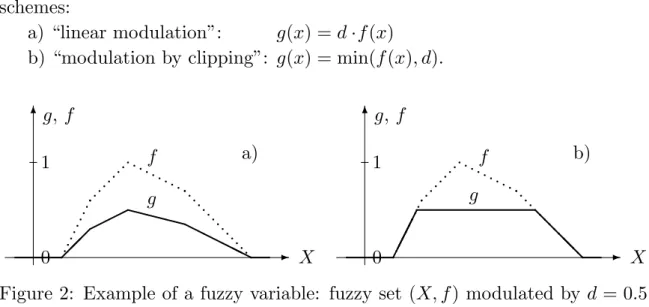

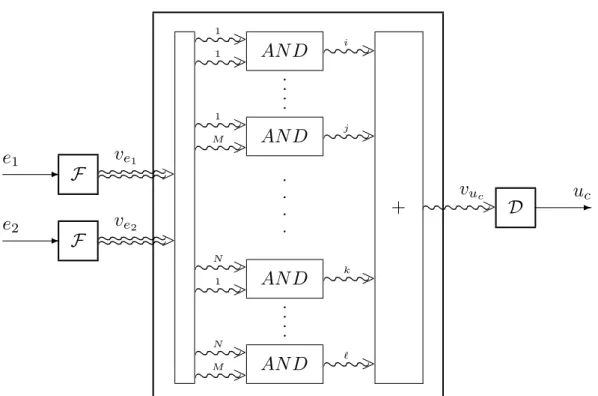

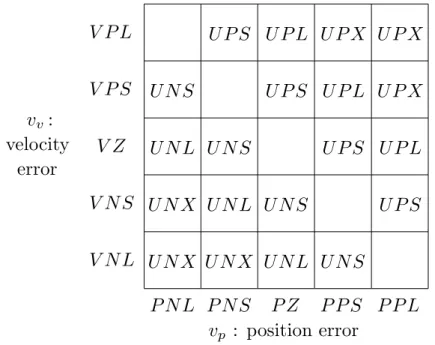
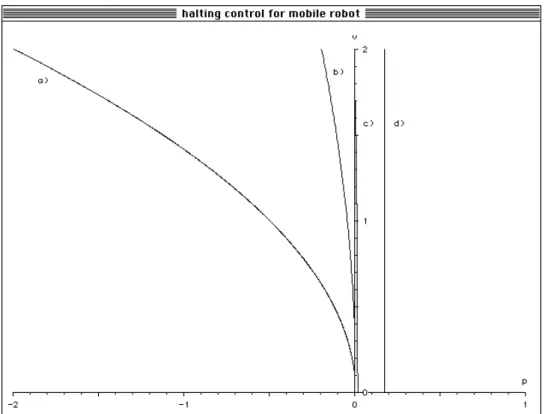
![Figure 12 shows the fuzzy sets covering the signal space A = [ − 180 ◦ , 180 ◦ ] where the line of sight angle α(t k ) lives](https://thumb-eu.123doks.com/thumbv2/1library_info/3905069.1525225/20.892.142.788.575.735/figure-shows-fuzzy-covering-signal-space-sight-angle.webp)
